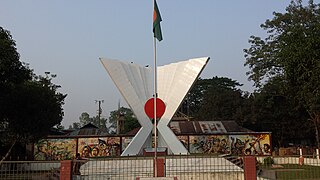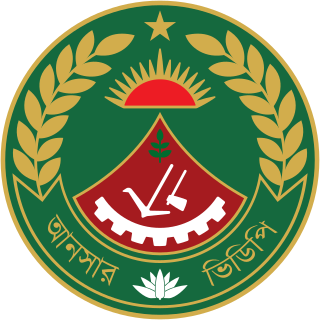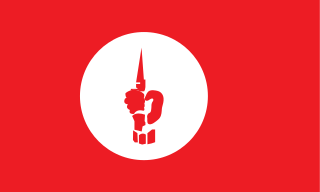
The Bangladesh Armed Forces are the military forces of the People's Republic of Bangladesh. They consist of the three uniformed military services: the Bangladesh Army, the Bangladesh Navy and the Bangladesh Air Force. The Armed Forces are under the jurisdiction of Ministry of Defence of the Government of Bangladesh, and are directly administered by the Armed Forces Division of the Prime Minister's Office. The President of Bangladesh serves as the Commander-in-Chief of the Bangladesh Armed Forces. Bangladesh has the third-largest defence budget in South Asia and according to the Global Firepower index, The Bangladeshi military is the 37th strongest in the World is the third most powerful military force in South Asia. Border Guard Bangladesh and Bangladesh Coast Guard are under the jurisdiction of the Ministry of Home Affairs during peacetime, but during wartime they fall under the command of Bangladesh Army and Bangladesh Navy respectively.

The Bangladesh Army is the land warfare branch and the largest component of the Bangladesh Armed Forces. The primary mission of the Army is to provide necessary forces and capabilities to deliver the Bangladeshi government's security and defence strategies and defending the nation's territorial integrity against external attack. Control of personnel and operations is administered by the Army Headquarters, Dhaka. The Bangladesh Army is also constitutionally obligated to assist the government and it's civilian agencies during times of domestic national emergency. This additional role is commonly referred to as "aid to civil administration".
Muhammad Ataul Gani Osmani, was a Bengali military leader. Osmani's career spanned five decades, beginning with service in the British Indian Army in 1939. He fought in the Burma Campaign during World War II. After the partition of India in 1947, he joined the Pakistan Army and served in the East Bengal Regiment, retiring as a colonel in 1967. Osmani joined the Provisional Government of Bangladesh in 1971 as the commander-in-chief of the nascent Bangladesh Forces. Regarded as the founder of the Bangladesh Armed Forces, Osmani retired as a four-star general from the Bangladesh Army in 1972.
The Razakar was an East Pakistani paramilitary force organised by General Tikka Khan in then East Pakistan, now called Bangladesh, during the Bangladesh Liberation War in 1971. The force committed war crimes during the war including massacring civilians, looting, and rape.

Mujibnagar, formerly known as Baidyanathtala (Boiddonathtola) and Bhoborpara, is a town in the Mujibnagar Upazila of Meherpur District in Khulna, Bangladesh. The Provisional Government of Bangladesh was formed on 10 April 1971, however, sworn in on 17 April 1971 in this place by the elected representatives of the Bengalees, that led the Bangladesh Liberation War, who were leading the guerrilla war for the independence of Bangladesh from Pakistan in 1971. The place was renamed Mujibnagar by the proclamation of independence, in honour of then imprisoned Sheikh Mujibur Rahman, who had declared Bangladesh independent. The actual capital of the government while in exile was Calcutta. A memorial complex covering 20.10 acres (8.13 ha) has been built at the site where the ministers of that first government took their oaths.

The Jatiya Rakkhi Bahini was a Bangladeshi para-military force formed in 1972 by the Sheikh Mujibur Rahman government.
The Al-Badr was a paramilitary force composed mainly of Bihari Muslims which operated in East Pakistan against the Bengali nationalist movement during the Bangladesh Liberation War, under the patronage of the Pakistani government.
The Al-Shams was an anti-Bangladesh paramilitary wing of several Islamist parties in East Pakistan composed of local Bengalis and Muhajirs that along with the Pakistan Army and the Al-Badr, is accused of conducting a mass killing campaign against Bengali nationalists, civilians, religious and ethnic minorities during 1971. The group was banned by the independent government of Bangladesh, but most of its members had fled the country during and after the Bangladesh Liberation War, which led to Bangladesh's independence.
Law enforcement in Bangladesh is one part of the Justice System in Bangladesh along with Prisons and Courts.

The Benelli Supernova is a pump action shotgun used for hunting, self-defense and law enforcement, made by Italian firearm manufacturer Benelli Armi SpA. The Supernova features a recoil reducer, which is attached to the interior of the stock, and raises the length of time that the shot's impulse is spread across, thus lowering felt recoil.

The Battle of Kamalpur, launched against the Pakistan Army, is one of the most significant military engagements fought by the Guerrilla armed resistance group, The Mukti Bahini in 1971 during it's war of independence from Pakistan. The Pakistani Army set up a military camp at Kamalpur which was attacked by 1st East Bengal Regiment of Z Force several times. The first attack was made on June 12, and a second attack was made on July 31, 1971, also another attack at 22 October 1971, in total there were 18 battles in Kamalpur, Syed Sadruzzaman Helal led 14 battles against the Pakistani Army which heavily weakened the Pakistani forces present in Kamalpur. India joined the war at Late November, they sent their military formations to take Kamalpur, but it was harder for the Indian Army than expected, they made more than 3 unsuccessful attempts to take Kamalpur, the Indian Army's moral was deteriorating, and Casualties were heavily increasing but they knew the Pakistani forces had no artillery, only 2 mortars left, finally, on December 4, the Pakistani Army was overrun and withdrawn and fell back to their headquarters at Jamalpur after an attack by the Bangladeshi Forces and the Indian Army. The Battle of Kamalpur was the deadliest major military engagement in the Bangladeshi War of Liberation, The Mukti Bahini lost 194 soldiers in the battle The Indian Army lost more than 46 soldiers in the battle and a 113 wounded Meanwhile, The Pakistani Army had the most casualties, The Pakistani Army lost 497 soldiers in the battle and around 162 and 220 soldiers captured In the aftermath of the battle, Pakistani troops were defeated and Jamalpur became liberated from Pakistani occupation.
The Eastern Command of the Pakistan Army also known as III Corps was a corps-sized military formation headed by a lieutenant-general, who was designated the Commander 3 Corps. After the partition of India by United Kingdom, the Islamic Republic of Pakistan was divided into two territories separated by 1,000 miles (1,600 km). Most of the assets of the Pakistan armed forces were stationed in West Pakistan; the role of the Pakistan armed forces in East Pakistan was to hold that part of the country until the Pakistani forces defeated India in the west. The Pakistan Army created the Eastern Command, with one commander in the rank of Lieutenant General responsible for the command. The armed forces, had drawn up a plan to defend Dhaka by concentrating all their forces along the Dhaka Bowl.

Prior to Bangladesh Liberation War in 1971, India had no plans for large scale military action in East Pakistan. Since the Sino-Indian War of 1962, the primary objective of the Indian Army Eastern Command was the defence of the Indian northern and eastern borders, defending the "Shiliguri Corridor", and on combating insurgencies raging in Mizoram, Nagaland, Manipur and the Naxalites in West Bengal.

The Village Defence Party (VDP) is a law enforcement force in Bangladesh, organised in distinct units at the level of individual villages and urban towns. It is administered by the Home Ministry of the central Government of Bangladesh. Although domestic security is its main objective, the Village Defence Parties are also specifically charged with working on village development and welfare schemes.

The Mukti Bahini, also known as the Bangladesh Forces, was the guerrilla resistance movement consisting of the Bangladeshi military, paramilitary and civilians during the Bangladesh Liberation War that transformed East Pakistan into Bangladesh in 1971. They were initially called the Mukti Fauj.
Mijanur Rahman Khan is a retired major general in the Bangladesh Army. He was the director general of national paramilitary Bangladesh Ansar and Village Defence Party.
Ansar-VDP Unnayan Bank is a specialised government owned bank in Bangladesh. The bank was founded to provide financial services to the paramilitary Bangladesh Ansar and Village Defence Party. Major General AKM Nazmul Hasan is the chairman of this bank. The bank has 259 branches across the country under 18 regions. It is one of four specialized banks owned by the government of Bangladesh; the rest are Bangladesh Krishi Bank, Karmasangsthan Bank, and Rajshahi Krishi Unnayan Bank.
The Bangladesh Ansar mutiny was a mutiny staged from 1 December to 4 December 1994, in Shafipur and Khilgaon by a section of the Bangladesh Ansar, a paramilitary force tasked with providing security to government installations and aiding law enforcement in Bangladesh. The mutiny prompted a series of reforms by the government.
Sheikh Pasha Habib Uddin OSP, SGP, BAMS, afwc, psc is a retired two-star rank Bangladesh Army officer whose last appointment was director general of the Bangladesh Institute of International and Strategic Studies (BIISS). Prior to join BIISS, he was senior directing staff at the National Defense College. Earlier, he was commandant, Bangladesh Ordnance Factories (BOF) and the director general of Bangladesh Ansar and Village Defence Party. He also served as the chairman of Ansar-VDP Unnayan Bank.
AKM Nazmul Hasan is a major general in the Bangladesh Army who is the incumbent director general of the Special Security Force. Prior to that he was DG of the Border Guards Bangladesh (BGB). Prior to that position, he served as director general of the Bangladesh Ansar and Village Defence Party. He also served as general officer commanding (GOC) of 11th Infantry Division and area commander, Bogura Area.














